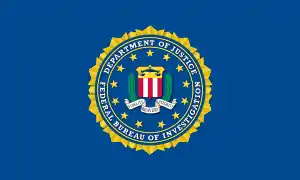National Incident-Based Reporting System
National Incident-Based Reporting System (NIBRS) is an incident-based reporting system used by law enforcement agencies in the United States for collecting and reporting data on crimes. Local, state and federal agencies generate NIBRS data from their records management systems. Data is collected on every incident and arrest in the Group A offense category. These Group A offenses are 49 offenses grouped in 23 crime categories. Specific facts about these offenses are gathered and reported in the NIBRS system. In addition to the Group A offenses, 10 Group B offenses are reported with only the arrest information.
| Federal Bureau of Investigation | |
|---|---|
 | |
 Badge of the Federal Bureau of Investigation | |
 | |
| Common name | Federal Bureau of Investigation |
| Abbreviation | FBI |
| Motto | Fidelity, Bravery, Integrity |
| Agency overview | |
| Formed | July 26, 1908 |
| Employees | 35,104[1] (October 31, 2014) |
| Annual budget | US$8.3 billion (FY 2014)[1] |
| Jurisdictional structure | |
| Federal agency (Operations jurisdiction) | United States |
| Operations jurisdiction | United States |
| Legal jurisdiction | As per operations jurisdiction |
| Governing body | U.S. Department of Justice |
| Constituting instrument | |
| General nature | |
| Operational structure | |
| Headquarters | J. Edgar Hoover Building Northwest, Washington, D.C. |
| Sworn members | 13,260 (October 31, 2014)[1] |
| Unsworn members | 18,306 (October 31, 2014)[1] |
| Agency executives |
|
| Child agencies | |
| Major units | 5
|
| Field offices | 56 (List of FBI Field Offices) |
| Notables | |
| People |
|
| Programs | |
| Significant Operations | |
| Website | |
| www | |
History
Uniform Crime Reports (UCR) began in the late 1920s when the Committee on Uniform Crime Records, established by the International Association of Chiefs of Police (IACP) in 1927, published the first version of the Uniform Crime Reporting Handbook. With this initiative, the Uniform Crime Reports program began under the jurisdiction of the Federal Bureau of Investigation. Over the years, the uniform crime report developed into a broad utility for summary-based reporting of crimes. By the late 1970s, the law enforcement community saw the need for a more detailed crime reporting program that would meet the needs of law enforcement agencies in the 21st century.
Testing for the new NIBRS system began in South Carolina. The new system was approved for general use at a national UCR conference in March, 1988.
Similarities and differences between SRS and NIBRS
The general concepts, such as jurisdictional rules, of collecting and reporting SRS (Summary Reporting System) data are the same as in NIBRS. However, NIBRS goes into much greater detail than SRS. NIBRS includes 24 Group A crime categories whereas SRS only has 8 crime categories classified as Part I.
In NIBRS, the definition of rape has been expanded to include male victims. SRS, until recently, defined rape as "the carnal knowledge of a female forcibly and against her will" but since has been expanded. Formerly in SRS, sex attacks against males were to be classified only as either assaults or "other sex offenses", depending on the nature of the crime and the extent of the injury.
When multiple crimes are committed by a single person or group of persons during the same basic period of time and same basic location, SRS uses a "Hierarchy Rule" (see UCR for details) to determine which offenses will be reported for that incident. Only the most serious offense is reported. For example, if a criminal burglarizes a residence and assaults the inhabitant, only the assault is reported as it takes precedence over the burglary on the "Hierarchy Rule". NIBRS reports all offenses involved in a particular incident.
SRS has only two crime categories: Crimes Against Persons (e.g., murder, rape, assault, robbery) and Crimes Against Property (e.g., car theft, burglary, larceny, arson). NIBRS adds a third category titled Crimes Against Society for activities such as drug or narcotic offenses and other activities prohibited by society's rules.
Finally, agencies submit SRS data in written documents that must then be hand entered into a computer system for statistical analysis. NIBRS data are submitted electronically in the form of ASCII text files. These files are then processed without the need for a person to input the data (except at the originating agency's initial filing of the report into their computer system).
Reported offense categories
Group A offenses[2]
- Animal Cruelty[3]
- Arson
- Assault (Aggravated, Simple, Intimidation)
- Bribery
- Burglary/Breaking and Entering
- Counterfeiting/Forgery
- Destruction/Damage/Vandalism of Property
- Drug/Narcotic Offenses (including drug equipment violations)
- Embezzlement
- Extortion/Blackmail
- Fraud (false pretenses/swindle/confidence game, credit card and ATM fraud, impersonation, welfare and wire fraud)
- Gambling (betting, wagering, operating/promoting/assisting gambling, gambling equipment violations, sports tampering)
- Homicide (murder and non-negligent manslaughter, negligent manslaughter, justifiable homicide)
- Human Trafficking
- Kidnapping/Abduction
- Larceny (pocket picking, purse snatching, shoplifting, theft and all other larceny)
- Motor vehicle theft
- Pornography/Obscene Material
- Prostitution Offenses (prostitution, assisting or promoting prostitution)
- Robbery
- Sex Offenses, Forcible (forcible rape, forcible sodomy, sexual assault with an object, forcible fondling)
- Sex Offenses, Non-forcible (incest, statutory rape)
- Stolen Property Offenses/Fence
- Weapon Law Violations
Group B offenses[2]
- Bad Checks
- Curfew/Loitering/Vagrancy Violations
- Disorderly Conduct
- Driving Under the Influence
- Drunkenness
- Family Offenses, Nonviolent
- Liquor Law Violations
- Peeping Tom
- Trespass of Real Property
- All Other Offenses
Use of NIBRS in the U.S.
As of October, 31, 2020, 8,742 law enforcement agencies representing 48.9 percent of the population were reporting NIBRS data to the UCR program. At that time, 43 states were NIBRS-certified as having records management systems that meet the FBI's requirement for collecting crime data according to established technical specifications. [FBI][4]
A number of states, such as Texas and South Carolina, use a customized version of NIBRS. These versions return the basic data required by the FBI, but include additional data required by the state. This additional data are supplied with an additional segment type (see below for information on data segments) or appended to the appropriate segment line. For example, the Texas system (TIBRs) includes an additional segment (Segment Level 8) with additional data elements such as number of drug labs or fields seized, precursor drug chemicals involved and family violence data. The South Carolina system (SCIBRs) includes data like second location type, victim's usage of drugs or alcohol and space for additional offenses on arrests (other than the specific offense for which the person was arrested). These data are appended to the appropriate segment type.
Data format
NIBRS data are submitted in an ASCII text format. There are 8 segments in the NIBRS system (numbered 0–7). Each segment is represented in a single line in the text file. Lines are separated with a newline character.
Zero-reporting segment
The Level 0 segment is only filed if an agency does not have any criminal offenses or arrests to report during a given reporting period.
Administrative segment
The Level 1 segment contains administrative information for a single incident. This information includes the incident number, date, time and a list of offenses. Only one Level 1 segment is submitted for each incident with an offense in the Group A category. For each Level 1 segment, there may be one or more segments from Levels 2 through 6.
Offense segment
A Level 2 segment is submitted for each offense and provides details on the offense such as the UCR offense code, whether or not the offense was completed, the location type, number of premises entered (only valid for burglaries), type of criminal activity and the type of weapon or force used in the crime.
Property segment
Any property involved in an offense is recorded in the Level 3 segment. The loss type (stolen, recovered, burned, seized, damaged, etc.), value, description and recovery date (only for recovered property) are provided as well as data on stolen and recovered motor vehicles and seized drugs.
Victim segment
Every victim involved in the incident is detailed in the Level 4 segment. The victim's age, sex, race, ethnicity, relationship to the offender(s), type of injury and special circumstances for certain offense types are recorded.
Offender segment
Each offender's age, sex and are reported using the Level 5 segment.
Arrestee segment
The Level 6 segment is filed for each person arrested under a Group A offense. The data submitted via this segment includes the arrest date, type and offense code. The arrestee's age, sex, race, ethnicity and resident status (whether or not the arrestee is a resident of the arresting agency's jurisdiction) are reported along with any weapons with which the arrestee was armed and a disposition code for arrestees under 18 years of age.
Group B arrest segment
Each person arrested under a Group B offense is reported using a Level 7 segment. The arrestee's age, sex, race, ethnicity and resident status are reported along with any weapons with which the arrestee was armed. A disposition code for arrestees under 18 years of age is also reported.
See also
References
- "Frequently Asked Questions". Federal Bureau of Investigation. Retrieved 2016-09-02.
- "Federal Bureau of Investigation National Incident-based Reporting System – Frequently Asked Questions (FAQs)". www2.fbi.gov. Retrieved 2016-02-10.
- https://www.fbi.gov/news/stories/2016/february/tracking-animal-cruelty/tracking-animal-cruelty
- FBI (November 10, 2020). "UCR Focuses on NIBRS and Other Tools to Make More Relevant Data Available to Users". FBI.gov. Retrieved 2021-01-19.
- Uniform Crime Reporting Handbook, 2004 edition
- National Incident-Based Reporting System – Volume 2: Data Submission Specifications, May 1992 edition